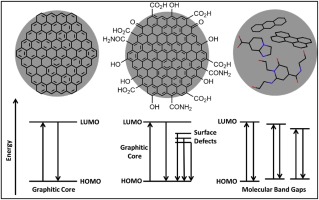Journal of Photochemistry and Photobiology C: Photochemistry Reviews ( IF 13.6 ) Pub Date : 2018-08-16 , DOI: 10.1016/j.jphotochemrev.2018.08.001 Monoj Kumar Barman , Amitava Patra

|
Fluorescent carbon dots (C-dots) are new class of nanomaterials with widespread applications in optoelectronics, bio-imaging, catalysis, and sensing. The origin of photoluminescence of carbon dots is a debatable issue which is pretend to depend on the chemical structures such as graphitic conjugated core, molecular fluorophores and the surface defect states found to be dependent on the method of preparation. In this review, we have illustrated the important issues and challenges of the luminescent carbon dots and their potential applications. Graphitic conjugated core containing carbon dots is being synthesized usually from bulk materials like graphite, graphene and graphene oxide which exhibit size dependent photoluminescence behaviour due to quantum confinement. On the other hand, carbon dots synthesized from small molecules exhibit excitation dependent emission due to the presence of surface energy trap states which can be tuned by surface modification. Again, presence of both conjugated core and surface defect generates dual emission property. It is evident that various molecular fluorophores are produced inside carbon dots during low temperature synthesis. Hetero-atom doping is another strategy to tune the photoluminescence properties of carbon dots. Red emitting carbon dots are found to be suitable for bio-imaging applications after surface modification. Again, high quantum yield and solar light absorbing carbon dots are required for light harvesting and optoelectronic applications. Surface modified carbon dots are found to be appropriate for sensing applications. Analysis reveals that carbon dots based hybrid systems provide good applicability towards construction of solar cell devices because of their efficient charge separation.
中文翻译:

碳点化学结构驱动的光致发光行为的现状与展望
荧光碳点(C-dots)是新型的纳米材料,在光电,生物成像,催化和传感领域具有广泛的应用。碳点的光致发光的起源是一个值得商bat的问题,它被认为取决于化学结构,例如石墨共轭核,分子荧光团和表面缺陷状态,其取决于制备方法。在这篇综述中,我们已经说明了发光碳点及其潜在应用的重要问题和挑战。通常由诸如石墨,石墨烯和氧化石墨烯之类的块状材料合成包含碳点的图形共轭核,这些块状材料由于量子限制而表现出尺寸依赖性的光致发光行为。另一方面,由小分子合成的碳点由于存在可以通过表面改性调节的表面能阱状态,因此呈现出与激发有关的发射。同样,共轭核心和表面缺陷的存在会产生双重发射特性。显然在低温合成期间在碳点内部产生了各种分子荧光团。杂原子掺杂是调节碳点的光致发光性质的另一种策略。发现在表面改性后,发红光的碳点适用于生物成像应用。同样,光收集和光电应用需要高量子产率和吸收太阳光的碳点。发现表面改性的碳点适用于传感应用。


























 京公网安备 11010802027423号
京公网安备 11010802027423号